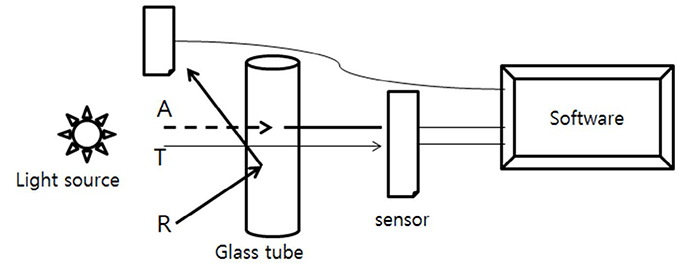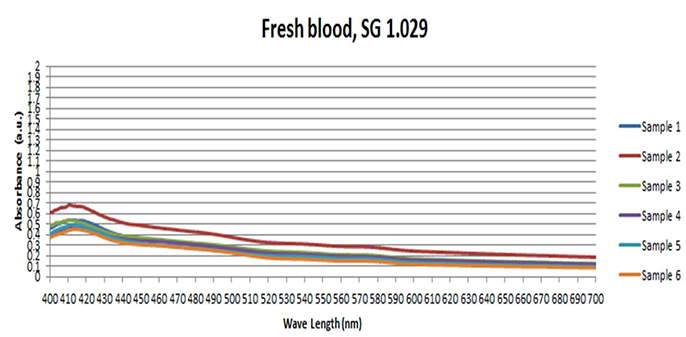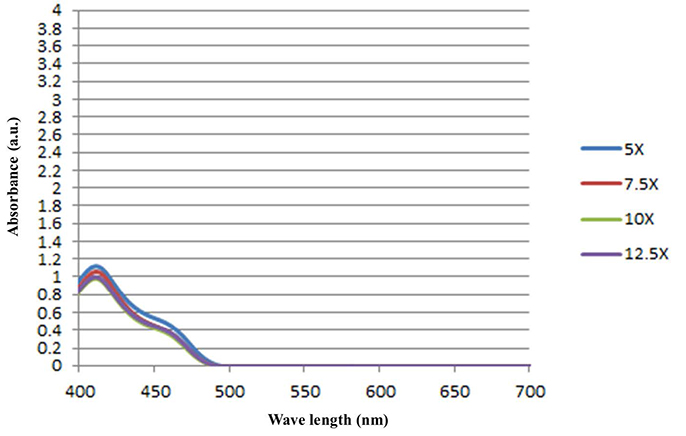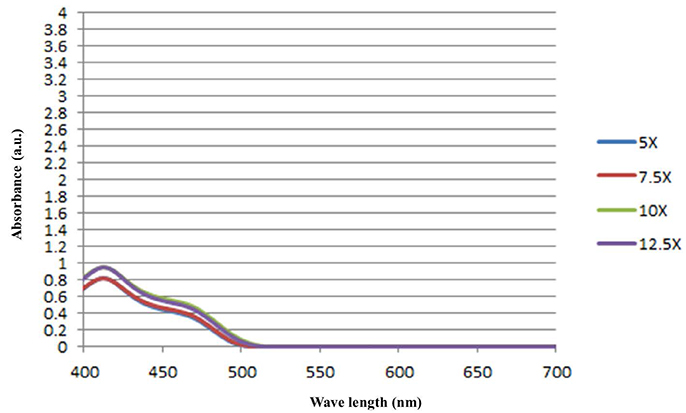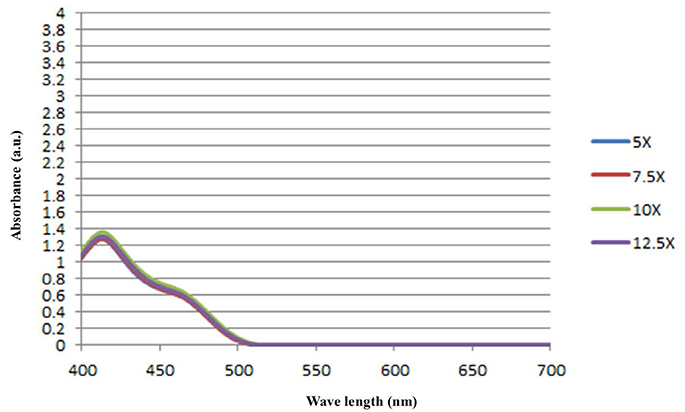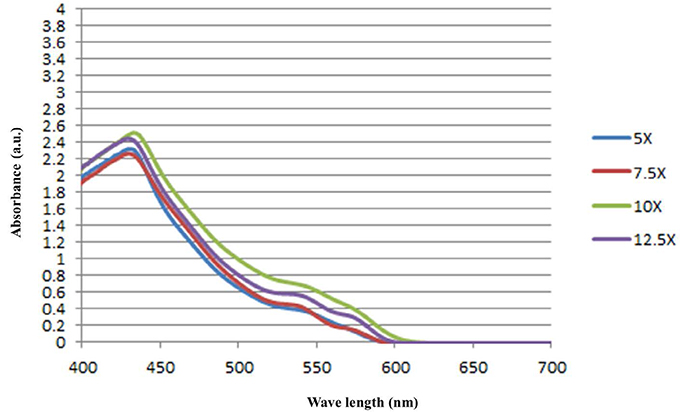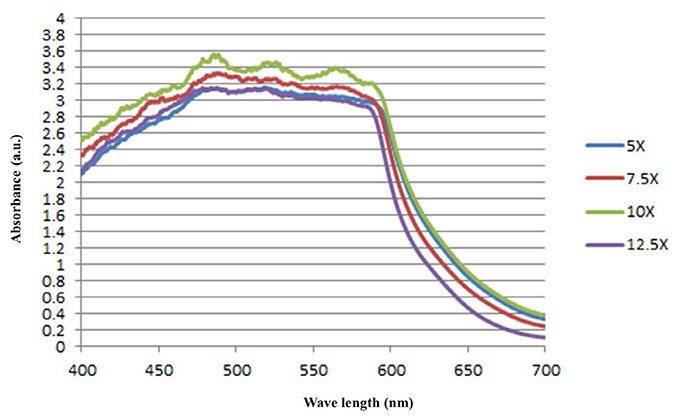Korean J Leg Med.
2018 Nov;42(4):126-140. 10.7580/kjlm.2018.42.4.126.
Analysis of the Absorbance Pattern of Postmortem Blood Sample Using Spectrometer
- Affiliations
-
- 1Biomedical Research Institute, Chonnam National University Hospital, Gwangju, Korea.
- 2Emergency Medical Center, Chonnam National University Hospital, Gwangju, Korea.
- 3Department of Forensic Medicine, Chonnam National University Medical School, Gwangju, Korea. jtpark@jnu.ac.kr
- KMID: 2427559
- DOI: http://doi.org/10.7580/kjlm.2018.42.4.126
Abstract
- The diagnosis of cause of death (COD) or estimation of postmortem interval (PMI) is hard to perform using postmortem blood or other bodily fluids due to various biochemical changes that occur during the agonal phase or after death. To solve these problems, new paradigms and new analytical methods are needed. In this study, postmortem blood was fractionated with specific gravity 1.021, 1.029, 1.038, and 1.045, and the absorbance patterns of each sample of the 131 total cases (12 kinds of COD) were analyzed using a spectrometer. The absorbance was grouped into 9 patterns (ABS pattern 1 to 9) according to the wave length and the signal intensity. These patterns of postmortem blood were found to be distinctly different from the absorbance pattern of fresh blood. The analysis of ABS patterns is useful for the diagnosis of deaths due to acute or rapid bleeding, fire death, drowning and, in some cases, poisoning, but is not useful for the estimation of PMI.
MeSH Terms
Figure
Reference
-
1. Wang K, Asinger RW, Marriott HJ. ST-segment elevation in conditions other than acute myocardial infarction. N Engl J Med. 2003; 349:2128–2135.
Article2. Hauser AM, Gangadharan V, Ramos RG, et al. Sequence of mechanical, electrocardiographic and clinical effects of repeated coronary artery occlusion in human beings: echocardiographic observations during coronary angioplasty. J Am Coll Cardiol. 1985; 5(2 pt 1):193–197.
Article3. Eggers KM, Oldgren J, Nordenskjold A, et al. Diagnostic value of serial measurement of cardiac markers in patients with chest pain: limited value of adding myoglobin to troponin I for exclusion of myocardial infarction. Am Heart J. 2004; 148:574–581.
Article4. Normand ST, Landrum MB, Guadagnoli E, et al. Validating recommendations for coronary angiography following acute myocardial infarction in the elderly: a matched analysis using propensity scores. J Clin Epidemiol. 2001; 54:387–398.5. Warraich HJ, Benson CC, Khosa F, et al. Diagnosis of acute myocardial infarction on computed tomography angiogram. Circulation. 2014; 129:272–273.
Article6. Min BW, Park JT, Choi JS. Postmortem biochemistry (I): cardiac markers. Korean J Leg Med. 2012; 36:1–14.7. Hausdorfer C, Pedal I, Zimmer G, et al. Catecholamines, myofibrillary degeneration of the heart muscle and cardiac troponin T in various types of agony. Arch Kriminol. 1995; 196:46–57.8. Matoba K, Terazawa K, Watanabe S, et al. Problems in applying a rapid assay kit for cardiac troponin T to medico-legal blood samples. Hokkaido Igaku Zasshi. 2006; 81:359–363.9. Zhu BL, Ishida K, Quan L, et al. Post-mortem urinary myoglobin levels with reference to the causes of death. Forensic Sci Int. 2001; 115:183–188.
Article10. Madea B. Is there recent progress in the estimation of the postmortem interval by means of thanatochemistry? Forensic Sci Int. 2005; 151:139–149.
Article11. Luna A. Is postmortem biochemistry really useful? Why is it not widely used in forensic pathology? Leg Med (Tokyo). 2009; 11:Suppl 1. S27–S30.
Article
- Full Text Links
- Actions
-
Cited
- CITED
-
- Close
- Share
- Similar articles
-
- Evaluation of Point-of-Care Testing for C-Reactive Protein in Forensic Medicine
- Study of the Test for Postmortem C-Reactive Protein in Routine Autopsy Practice
- Membrane-Introduction Mass Spectrometry Analysis of Desflurane, Propofol and Fentanyl in Plasma and Cerebrospinal Fluid for Estimation BBB Properties
- The Realities of Postmortem Investigation and Examination in Chungju, Eumseong Provinces
- Biochemical Analysis on Postmortem Specimens

